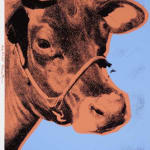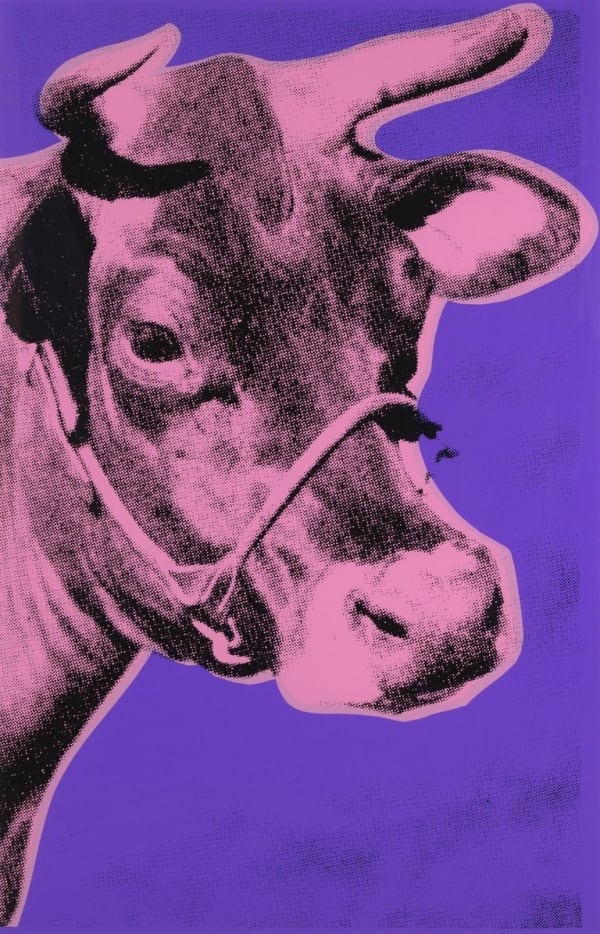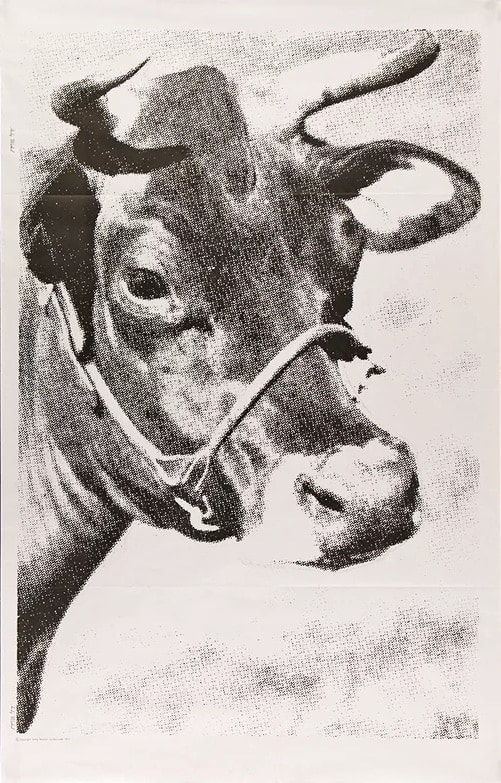

Andy Warhol
115.6 x 75.6 cm
Cow (FS. II 11A) is one of four distinct screenprints from Andy Warhol’s Cow Series, originally published in 1966 to coincide with the opening of his exhibition at the Leo Castelli Gallery in New York. Rather than hanging traditional framed works, Warhol boldly used these colorful, almost euphoric cow images as wallpaper to cover the gallery’s walls—transforming the entire space into a Pop Art installation.
Warhol’s career in Pop Art was controversial from the start. His unapologetic embrace of commercial aesthetics, flat imagery, and mass production clashed with the prevailing ideals of abstraction and artistic “seriousness.” Much of the criticism aimed at Warhol stemmed not only from his bold visual style, but also from his choice of subject matter. By depicting everyday items and figures drawn from advertising, supermarkets, and pop culture, Warhol challenged the art world to reconsider what could—or should—be considered art.
The idea for the Cow series came from legendary art dealer Ivan Karp, who suggested the cow as a timeless and iconic subject in art history, describing it as “wonderfully pastoral.” Warhol responded with characteristic irony and flair, creating a series of garishly colored cow heads set against vibrant backgrounds. The subject marked a shift from his earlier explorations of celebrity and consumer goods, yet remained deeply aligned with his Pop ethos: taking something ordinary and rendering it extraordinary through repetition, scale, and color.
Cow (FS. II 11A) is notable for its relatively subdued color palette compared to other prints in the series. Featuring a hazy blue background paired with a warm, rich brown cow, this version evokes the nostalgic charm of children’s storybooks or rural landscapes. It softens Warhol’s usual high-contrast brashness, creating a whimsical yet grounded composition. The result is playful and oddly tender—inviting viewers to reconnect with nature through a familiar, almost folkloric lens.
Despite its gentle tone, the print remains conceptually sharp. Warhol's depiction of the cow doesn’t sentimentalize or romanticize the animal. Instead, it subtly mirrors the way cows exist in modern culture: as commodified creatures, raised en masse for human consumption. In this way, Cow (FS. II 11A) overlaps both stylistically and thematically with Warhol’s more obvious consumer-oriented works, such as his Campbell’s Soup Cans, in which the cow itself is sometimes an ingredient. By presenting the cow as both image and product, Warhol underscores the blurring of lines between nature, commodity, and culture.
Moreover, Cow (FS. II 11A) exemplifies Warhol’s growing command of the Pop Art style he helped pioneer. While his early work focused on elevating consumer goods and celebrity faces, the Cow series expanded the movement’s reach. By applying his signature silkscreen method and color manipulation to a traditionally pastoral subject, Warhol demonstrated that anything—be it a soup can, a movie star, or a barnyard animal—could be transformed into a cultural icon.
The Cow portfolio also holds significance as Warhol’s first major foray into wallpaper, a medium that would become central to his exhibition practice. His later shows often featured walls plastered with repeating images—whether of skulls, celebrities, or camouflage—creating immersive environments that blurred the boundaries between fine art, design, and decoration. Of all his wallpaper experiments, the Cow series remains among the most recognizable, both for its surprising subject and its visual punch.
Printed by Bill Miller’s Wallpaper Studio, Inc. in New York, Warhol’s Cows reflect the intersection of art and commerce that defined much of his career. They are at once humorous and serious, decorative and critical, high and low. In Cow (FS. II 11A), Warhol managed to distill these contrasts into a single image that captures the full complexity of his artistic vision.
Ultimately, Cow (FS. II 11A) is a testament to Warhol’s ability to take the familiar and make it strange—and in doing so, reveal deeper truths about culture, perception, and value. By turning the humble cow into a Pop icon, Warhol not only expanded the definition of art but also invited viewers to see the everyday world with fresh eyes.
For more information on Cow (FS. II 11A) for sale or to buy Cow (FS. II 11A), contact our galleries using the form below.Join our mailing list
* denotes required fields
We will process the personal data you have supplied in accordance with our privacy policy (available on request). You can unsubscribe or change your preferences at any time by clicking the link in our emails.
This website uses cookies
This site uses cookies to help make it more useful to you. Find out more about cookies.





